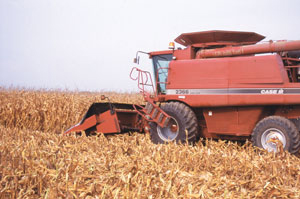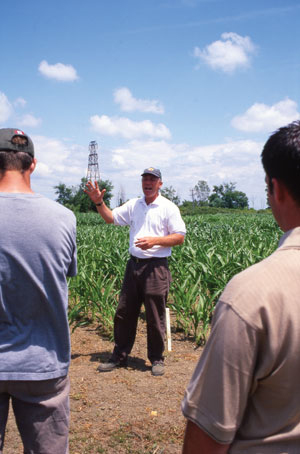
Features
Agronomy
Fertility and Nutrients
Saving money through tweaking inputs
The high cost of inputs in 2008 has shocked many growers, especially corn producers. But because strong returns on commodities were expected at harvest, farmers have not risked lower bushel counts by making significant input cutbacks in order to save money.
November 14, 2008 By Top Crop Manager
Wise decisions are based on good information.

|
|
| Maximizing yields at harvest begins with soil sampling in the spring, at least once every three years, to determine exact levels of P and K. |
The high cost of inputs in 2008 has shocked many growers, especially corn producers. But because strong returns on commodities were expected at harvest, farmers have not risked lower bushel counts by making significant input cutbacks in order to save money.
Small reductions in fertilizer inputs are being achieved, however, by producers who manage their soil very closely. The ability to do this will become even more important in 2009, say experts, when prices of both inputs and crops are likely to be just as high, if not higher.
Fred Sinclair, manager of product development for Pride Seeds, says, “I think we’re going into a time period where farmers can tweak inputs just a little bit, or some maybe a lot, and that’s going to help with the shell shock of higher expenses to trade off for the higher commodities.”
Sinclair also stresses that each farm is a case of its own. “Cropping is really different now than it was seven years ago where there’d be a lot of common things,” he says. “It seems now everyone has a different way of planting, tillage practices and fertility.”
Importance of testing
No matter the specific cropping practices used, any attempt by producers to tweak inputs should begin with proper soil testing. Greg Stewart, corn industry program lead for the Ontario Ministry of Agriculture, Food and Rural Affairs, says, “I would think that it would be foolhardy to make any sort of cost shaving decisions for P and K without really having a good handle on your soil test level on a field by field basis. It would be the first thing a farmer would want to do when he sees sky-high P and K costs.”
Sinclair agrees strongly that soil tests are worth the time and effort: “The return is greater than the cost.” He says “It’s probably a time period where growers almost want to protect what they’re investing in, where you want maintain, and then maybe build certain fields. You don’t have to build your overall program for fertility.” He adds, “To maintain, you need a report card. That soil test is one component. By using that soil test, you can start to pencil in and say, ‘Okay, here is where I can maybe save a little, this is where I have to add a little’ and at the end of the day, not over-fertilize or overspend, but not lose yield at the same time.”
 |
|
| Despite higher input costs, OMAFRA’s Greg Stewart notes fuel expenses account for less money than expected, and have less of an impact than drying costs or the price of nitrogen. |
When growers who have traditionally broadcast P and K at reasonably high levels see their soil test results, Stewart says they may find that they can take the opportunity to “live off” of what they have applied during previous years. However, he adds, “For those people who have new land, rented land or for those people who have shaved it fairly close to the bone in previous years and do not have high phosphorus or potash soil test levels, they’re going to have to continue to meet the minimum needs of the crop and it’s probably going to cost them a fair bit more.”
OMAFRA recommends soil testing every three years, a practice Stewart estimates is being used by about 50 per cent of growers. This may be due to the time needed to do the tests, says Stewart. He also suggests some farmers may not think they need a soil check if they have been applying the same fertility package for years and are convinced that is what the crop takes out of the soil.
To help closely manage nitrogen, Stewart advises examination “on a field by field, rotation by rotation, hopefully Calculator by Calculator approach.” He is referring to OMAFRA’s ‘Ontario Nitrogen Calculator’ (available at www.gocorn.net since 2006). The program is based on analysis of more than 600 site-years of corn yield measurements in response to rates of applied nitrogen. The calculator is site-specific, and factors in target yield, soil texture, previous crop, heat units and timing. Stewart says the dataset, which is the largest in the Ontario corn belt, also accounts for the price ratio between estimated corn profits and nitrogen costs for the current year.
Leanne Freitag, an agronomist with Cargill, says that in addition to soil testing, scouting fields and good record keeping are very important ways to manage inputs. “If you’re not out there, you don’t know what you’re missing,” she advises. “If you are scouting your fields on a regular basis, you see which weeds are there and the size of weeds. Then you can time herbicide applications more accurately, as well as the product and rate you’re spraying.” That means costs are minimized and benefits are maximized.
In addition, Freitag notes scouting is also integral to picking up on pests and diseases that could be robbing yield. “Every year we see different pests that are a problem,” she says. In 2008, for example, Freitag has observed higher bean leaf beetle populations in new areas and an armyworm outbreak in wheat.
As fields are scouted, the information gathered should be added to producer records. Freitag says good record keeping helps growers keep track of problem weeds, soil insects, and other issues, which will help when planning input needs such as seed and chemicals for the following year. “It’s better to have a plan in place well ahead of time and change it,” she says, “than to not have a plan at all.”
Working with a crop consultant can help maximize input returns and ensure crops are being managed in the most effective way possible. Companies offer myriad services, from record keeping to scouting and beyond.
Other management factors
When asked if high input costs might result in reduced rotation in the next few seasons, Stewart says, “All commodity prices have been relatively strong and I don’t get a sense in the countryside that there’s a real big appetite for trying to swing one way or the other. The classic Ontario corn-soy-winter wheat rotation I think is still very much the backbone of most cropping operations.” Sinclair agrees, adding, “Commodity prices look good the next couple of seasons, actually encouraging that the majority of people will follow their rotations.”
Stewart does concede that “certainly when input prices go very high, it does favour soybean over corn.” He also does not believe that high input costs will cause many growers to attempt to save fuel money by using reduced till or no-till practices. “The diesel fuel fraction of the total cropping budget is quite small in comparison to inputs,” he says. Farmers may feel that they are spending a lot on fuel these days, but “if they sit down and look at their total budgets,” says Stewart, “it’s still a smaller fraction and it can swing more wildly and have less impact than, say, the price of drying the corn or the price of nitrogen.”